Organisational Behavior: A Case Study of Starbucks during the Global Recession
VerifiedAdded on 2023/06/08
|10
|3107
|195
AI Summary
This report examines how organizational behavioural factors contributed towards a real-life organizational failure of Starbucks during the global recession. It includes an internal analysis of SWOT and external analysis of PESTEL, strategies implemented, effectiveness of those strategies, and alternative recommendations.
Contribute Materials
Your contribution can guide someone’s learning journey. Share your
documents today.
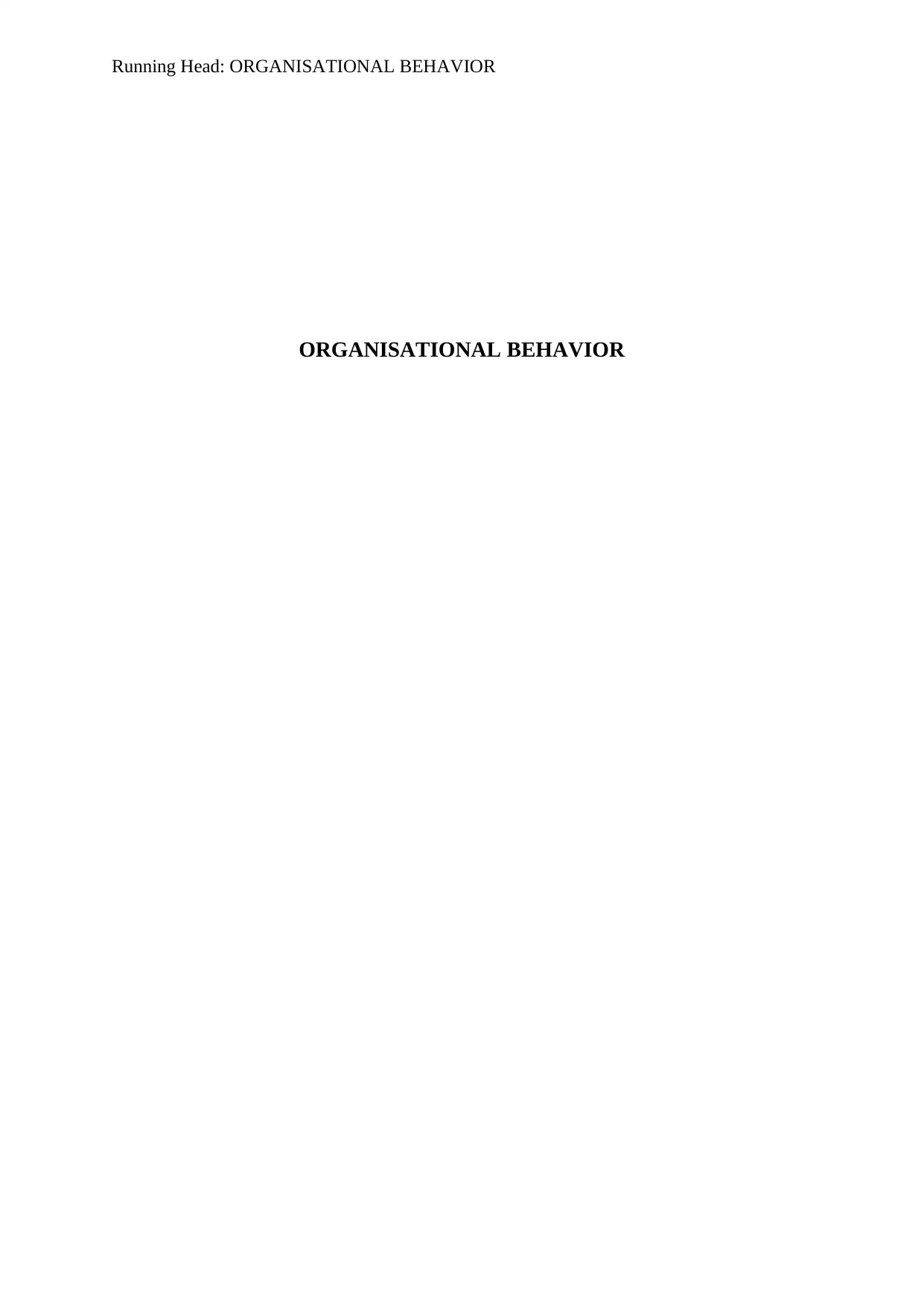
Running Head: ORGANISATIONAL BEHAVIOR
ORGANISATIONAL BEHAVIOR
ORGANISATIONAL BEHAVIOR
Secure Best Marks with AI Grader
Need help grading? Try our AI Grader for instant feedback on your assignments.
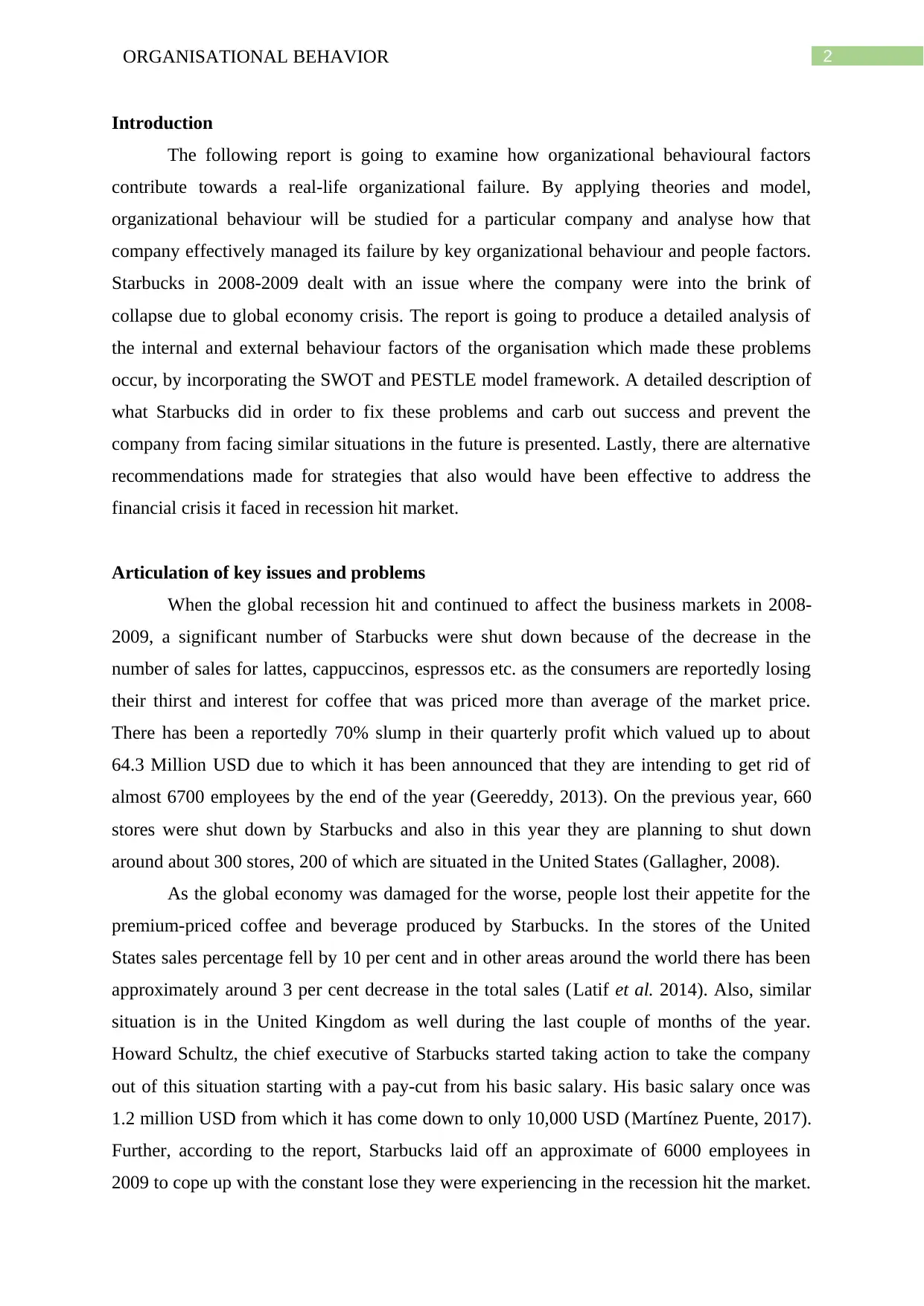
2ORGANISATIONAL BEHAVIOR
Introduction
The following report is going to examine how organizational behavioural factors
contribute towards a real-life organizational failure. By applying theories and model,
organizational behaviour will be studied for a particular company and analyse how that
company effectively managed its failure by key organizational behaviour and people factors.
Starbucks in 2008-2009 dealt with an issue where the company were into the brink of
collapse due to global economy crisis. The report is going to produce a detailed analysis of
the internal and external behaviour factors of the organisation which made these problems
occur, by incorporating the SWOT and PESTLE model framework. A detailed description of
what Starbucks did in order to fix these problems and carb out success and prevent the
company from facing similar situations in the future is presented. Lastly, there are alternative
recommendations made for strategies that also would have been effective to address the
financial crisis it faced in recession hit market.
Articulation of key issues and problems
When the global recession hit and continued to affect the business markets in 2008-
2009, a significant number of Starbucks were shut down because of the decrease in the
number of sales for lattes, cappuccinos, espressos etc. as the consumers are reportedly losing
their thirst and interest for coffee that was priced more than average of the market price.
There has been a reportedly 70% slump in their quarterly profit which valued up to about
64.3 Million USD due to which it has been announced that they are intending to get rid of
almost 6700 employees by the end of the year (Geereddy, 2013). On the previous year, 660
stores were shut down by Starbucks and also in this year they are planning to shut down
around about 300 stores, 200 of which are situated in the United States (Gallagher, 2008).
As the global economy was damaged for the worse, people lost their appetite for the
premium-priced coffee and beverage produced by Starbucks. In the stores of the United
States sales percentage fell by 10 per cent and in other areas around the world there has been
approximately around 3 per cent decrease in the total sales (Latif et al. 2014). Also, similar
situation is in the United Kingdom as well during the last couple of months of the year.
Howard Schultz, the chief executive of Starbucks started taking action to take the company
out of this situation starting with a pay-cut from his basic salary. His basic salary once was
1.2 million USD from which it has come down to only 10,000 USD (Martínez Puente, 2017).
Further, according to the report, Starbucks laid off an approximate of 6000 employees in
2009 to cope up with the constant lose they were experiencing in the recession hit the market.
Introduction
The following report is going to examine how organizational behavioural factors
contribute towards a real-life organizational failure. By applying theories and model,
organizational behaviour will be studied for a particular company and analyse how that
company effectively managed its failure by key organizational behaviour and people factors.
Starbucks in 2008-2009 dealt with an issue where the company were into the brink of
collapse due to global economy crisis. The report is going to produce a detailed analysis of
the internal and external behaviour factors of the organisation which made these problems
occur, by incorporating the SWOT and PESTLE model framework. A detailed description of
what Starbucks did in order to fix these problems and carb out success and prevent the
company from facing similar situations in the future is presented. Lastly, there are alternative
recommendations made for strategies that also would have been effective to address the
financial crisis it faced in recession hit market.
Articulation of key issues and problems
When the global recession hit and continued to affect the business markets in 2008-
2009, a significant number of Starbucks were shut down because of the decrease in the
number of sales for lattes, cappuccinos, espressos etc. as the consumers are reportedly losing
their thirst and interest for coffee that was priced more than average of the market price.
There has been a reportedly 70% slump in their quarterly profit which valued up to about
64.3 Million USD due to which it has been announced that they are intending to get rid of
almost 6700 employees by the end of the year (Geereddy, 2013). On the previous year, 660
stores were shut down by Starbucks and also in this year they are planning to shut down
around about 300 stores, 200 of which are situated in the United States (Gallagher, 2008).
As the global economy was damaged for the worse, people lost their appetite for the
premium-priced coffee and beverage produced by Starbucks. In the stores of the United
States sales percentage fell by 10 per cent and in other areas around the world there has been
approximately around 3 per cent decrease in the total sales (Latif et al. 2014). Also, similar
situation is in the United Kingdom as well during the last couple of months of the year.
Howard Schultz, the chief executive of Starbucks started taking action to take the company
out of this situation starting with a pay-cut from his basic salary. His basic salary once was
1.2 million USD from which it has come down to only 10,000 USD (Martínez Puente, 2017).
Further, according to the report, Starbucks laid off an approximate of 6000 employees in
2009 to cope up with the constant lose they were experiencing in the recession hit the market.
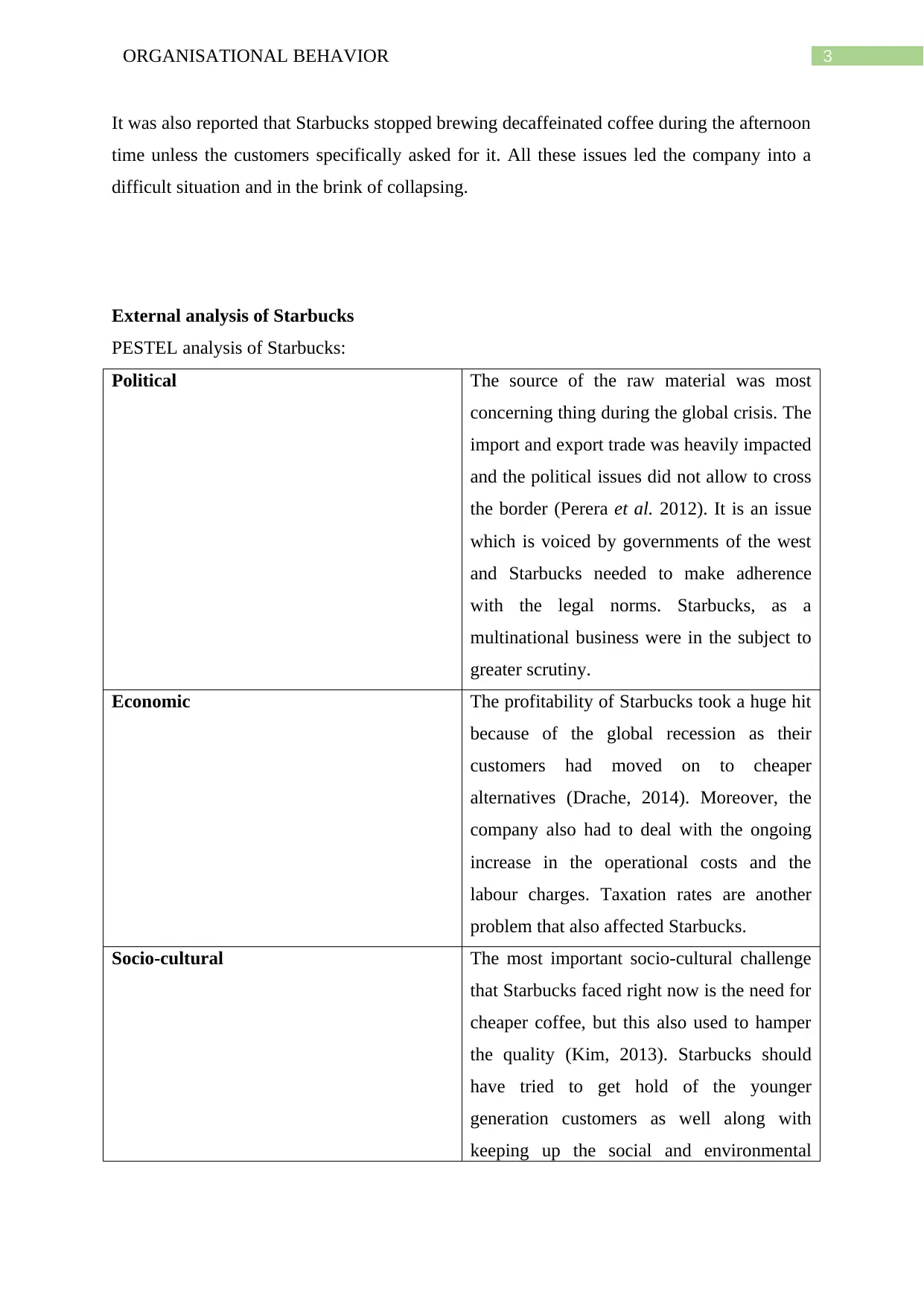
3ORGANISATIONAL BEHAVIOR
It was also reported that Starbucks stopped brewing decaffeinated coffee during the afternoon
time unless the customers specifically asked for it. All these issues led the company into a
difficult situation and in the brink of collapsing.
External analysis of Starbucks
PESTEL analysis of Starbucks:
Political The source of the raw material was most
concerning thing during the global crisis. The
import and export trade was heavily impacted
and the political issues did not allow to cross
the border (Perera et al. 2012). It is an issue
which is voiced by governments of the west
and Starbucks needed to make adherence
with the legal norms. Starbucks, as a
multinational business were in the subject to
greater scrutiny.
Economic The profitability of Starbucks took a huge hit
because of the global recession as their
customers had moved on to cheaper
alternatives (Drache, 2014). Moreover, the
company also had to deal with the ongoing
increase in the operational costs and the
labour charges. Taxation rates are another
problem that also affected Starbucks.
Socio-cultural The most important socio-cultural challenge
that Starbucks faced right now is the need for
cheaper coffee, but this also used to hamper
the quality (Kim, 2013). Starbucks should
have tried to get hold of the younger
generation customers as well along with
keeping up the social and environmental
It was also reported that Starbucks stopped brewing decaffeinated coffee during the afternoon
time unless the customers specifically asked for it. All these issues led the company into a
difficult situation and in the brink of collapsing.
External analysis of Starbucks
PESTEL analysis of Starbucks:
Political The source of the raw material was most
concerning thing during the global crisis. The
import and export trade was heavily impacted
and the political issues did not allow to cross
the border (Perera et al. 2012). It is an issue
which is voiced by governments of the west
and Starbucks needed to make adherence
with the legal norms. Starbucks, as a
multinational business were in the subject to
greater scrutiny.
Economic The profitability of Starbucks took a huge hit
because of the global recession as their
customers had moved on to cheaper
alternatives (Drache, 2014). Moreover, the
company also had to deal with the ongoing
increase in the operational costs and the
labour charges. Taxation rates are another
problem that also affected Starbucks.
Socio-cultural The most important socio-cultural challenge
that Starbucks faced right now is the need for
cheaper coffee, but this also used to hamper
the quality (Kim, 2013). Starbucks should
have tried to get hold of the younger
generation customers as well along with
keeping up the social and environmental
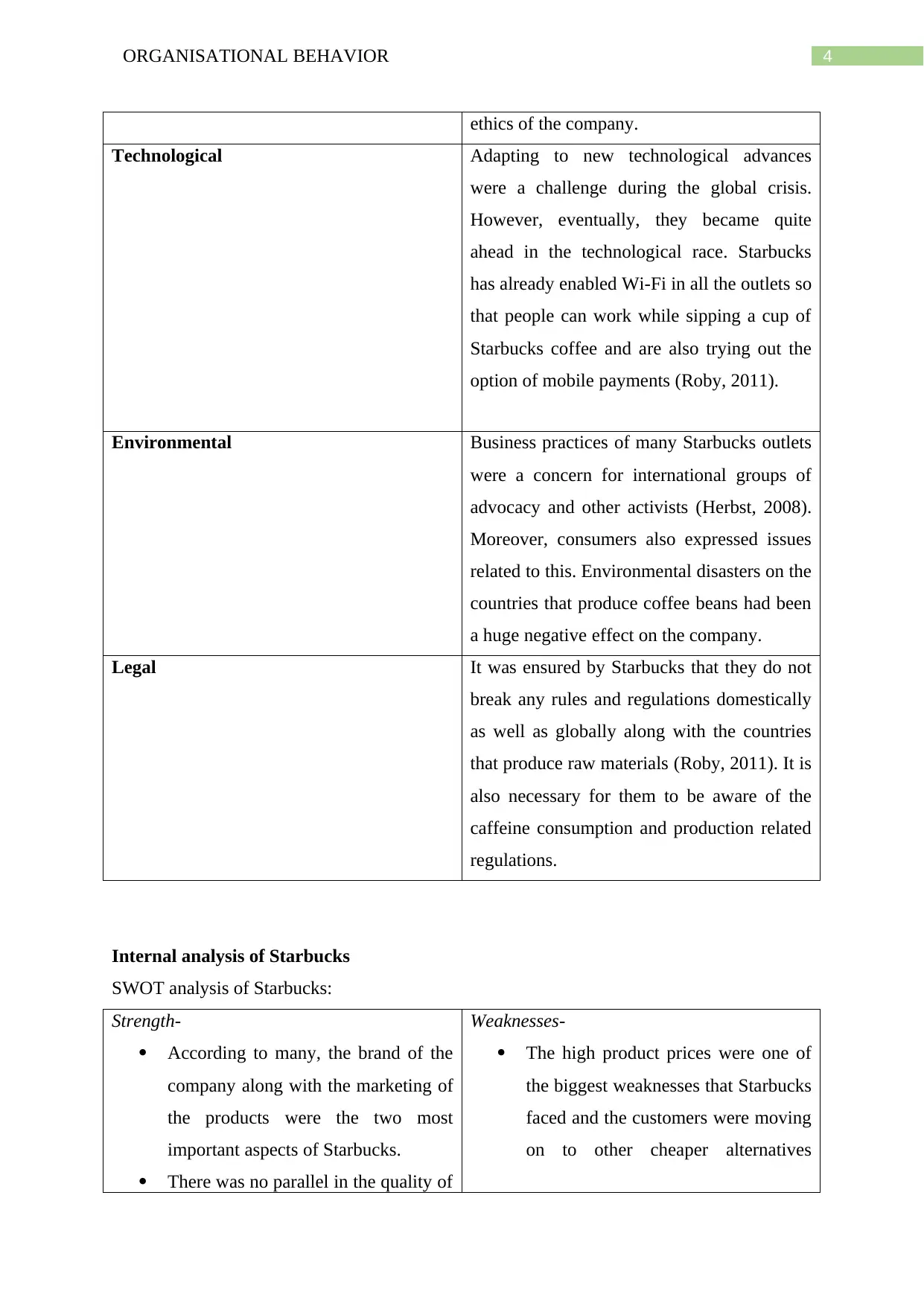
4ORGANISATIONAL BEHAVIOR
ethics of the company.
Technological Adapting to new technological advances
were a challenge during the global crisis.
However, eventually, they became quite
ahead in the technological race. Starbucks
has already enabled Wi-Fi in all the outlets so
that people can work while sipping a cup of
Starbucks coffee and are also trying out the
option of mobile payments (Roby, 2011).
Environmental Business practices of many Starbucks outlets
were a concern for international groups of
advocacy and other activists (Herbst, 2008).
Moreover, consumers also expressed issues
related to this. Environmental disasters on the
countries that produce coffee beans had been
a huge negative effect on the company.
Legal It was ensured by Starbucks that they do not
break any rules and regulations domestically
as well as globally along with the countries
that produce raw materials (Roby, 2011). It is
also necessary for them to be aware of the
caffeine consumption and production related
regulations.
Internal analysis of Starbucks
SWOT analysis of Starbucks:
Strength-
According to many, the brand of the
company along with the marketing of
the products were the two most
important aspects of Starbucks.
There was no parallel in the quality of
Weaknesses-
The high product prices were one of
the biggest weaknesses that Starbucks
faced and the customers were moving
on to other cheaper alternatives
ethics of the company.
Technological Adapting to new technological advances
were a challenge during the global crisis.
However, eventually, they became quite
ahead in the technological race. Starbucks
has already enabled Wi-Fi in all the outlets so
that people can work while sipping a cup of
Starbucks coffee and are also trying out the
option of mobile payments (Roby, 2011).
Environmental Business practices of many Starbucks outlets
were a concern for international groups of
advocacy and other activists (Herbst, 2008).
Moreover, consumers also expressed issues
related to this. Environmental disasters on the
countries that produce coffee beans had been
a huge negative effect on the company.
Legal It was ensured by Starbucks that they do not
break any rules and regulations domestically
as well as globally along with the countries
that produce raw materials (Roby, 2011). It is
also necessary for them to be aware of the
caffeine consumption and production related
regulations.
Internal analysis of Starbucks
SWOT analysis of Starbucks:
Strength-
According to many, the brand of the
company along with the marketing of
the products were the two most
important aspects of Starbucks.
There was no parallel in the quality of
Weaknesses-
The high product prices were one of
the biggest weaknesses that Starbucks
faced and the customers were moving
on to other cheaper alternatives
Secure Best Marks with AI Grader
Need help grading? Try our AI Grader for instant feedback on your assignments.
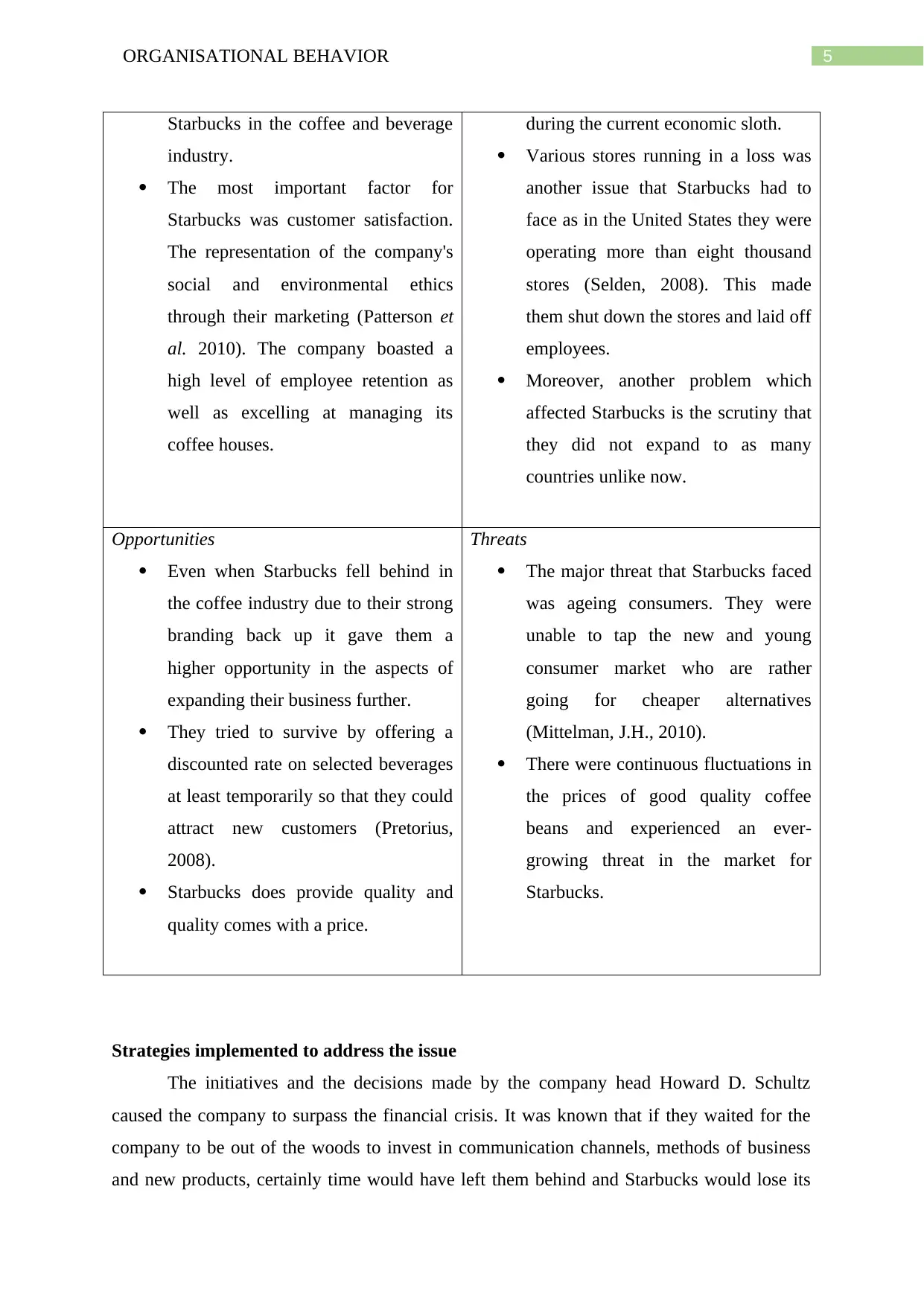
5ORGANISATIONAL BEHAVIOR
Starbucks in the coffee and beverage
industry.
The most important factor for
Starbucks was customer satisfaction.
The representation of the company's
social and environmental ethics
through their marketing (Patterson et
al. 2010). The company boasted a
high level of employee retention as
well as excelling at managing its
coffee houses.
during the current economic sloth.
Various stores running in a loss was
another issue that Starbucks had to
face as in the United States they were
operating more than eight thousand
stores (Selden, 2008). This made
them shut down the stores and laid off
employees.
Moreover, another problem which
affected Starbucks is the scrutiny that
they did not expand to as many
countries unlike now.
Opportunities
Even when Starbucks fell behind in
the coffee industry due to their strong
branding back up it gave them a
higher opportunity in the aspects of
expanding their business further.
They tried to survive by offering a
discounted rate on selected beverages
at least temporarily so that they could
attract new customers (Pretorius,
2008).
Starbucks does provide quality and
quality comes with a price.
Threats
The major threat that Starbucks faced
was ageing consumers. They were
unable to tap the new and young
consumer market who are rather
going for cheaper alternatives
(Mittelman, J.H., 2010).
There were continuous fluctuations in
the prices of good quality coffee
beans and experienced an ever-
growing threat in the market for
Starbucks.
Strategies implemented to address the issue
The initiatives and the decisions made by the company head Howard D. Schultz
caused the company to surpass the financial crisis. It was known that if they waited for the
company to be out of the woods to invest in communication channels, methods of business
and new products, certainly time would have left them behind and Starbucks would lose its
Starbucks in the coffee and beverage
industry.
The most important factor for
Starbucks was customer satisfaction.
The representation of the company's
social and environmental ethics
through their marketing (Patterson et
al. 2010). The company boasted a
high level of employee retention as
well as excelling at managing its
coffee houses.
during the current economic sloth.
Various stores running in a loss was
another issue that Starbucks had to
face as in the United States they were
operating more than eight thousand
stores (Selden, 2008). This made
them shut down the stores and laid off
employees.
Moreover, another problem which
affected Starbucks is the scrutiny that
they did not expand to as many
countries unlike now.
Opportunities
Even when Starbucks fell behind in
the coffee industry due to their strong
branding back up it gave them a
higher opportunity in the aspects of
expanding their business further.
They tried to survive by offering a
discounted rate on selected beverages
at least temporarily so that they could
attract new customers (Pretorius,
2008).
Starbucks does provide quality and
quality comes with a price.
Threats
The major threat that Starbucks faced
was ageing consumers. They were
unable to tap the new and young
consumer market who are rather
going for cheaper alternatives
(Mittelman, J.H., 2010).
There were continuous fluctuations in
the prices of good quality coffee
beans and experienced an ever-
growing threat in the market for
Starbucks.
Strategies implemented to address the issue
The initiatives and the decisions made by the company head Howard D. Schultz
caused the company to surpass the financial crisis. It was known that if they waited for the
company to be out of the woods to invest in communication channels, methods of business
and new products, certainly time would have left them behind and Starbucks would lose its
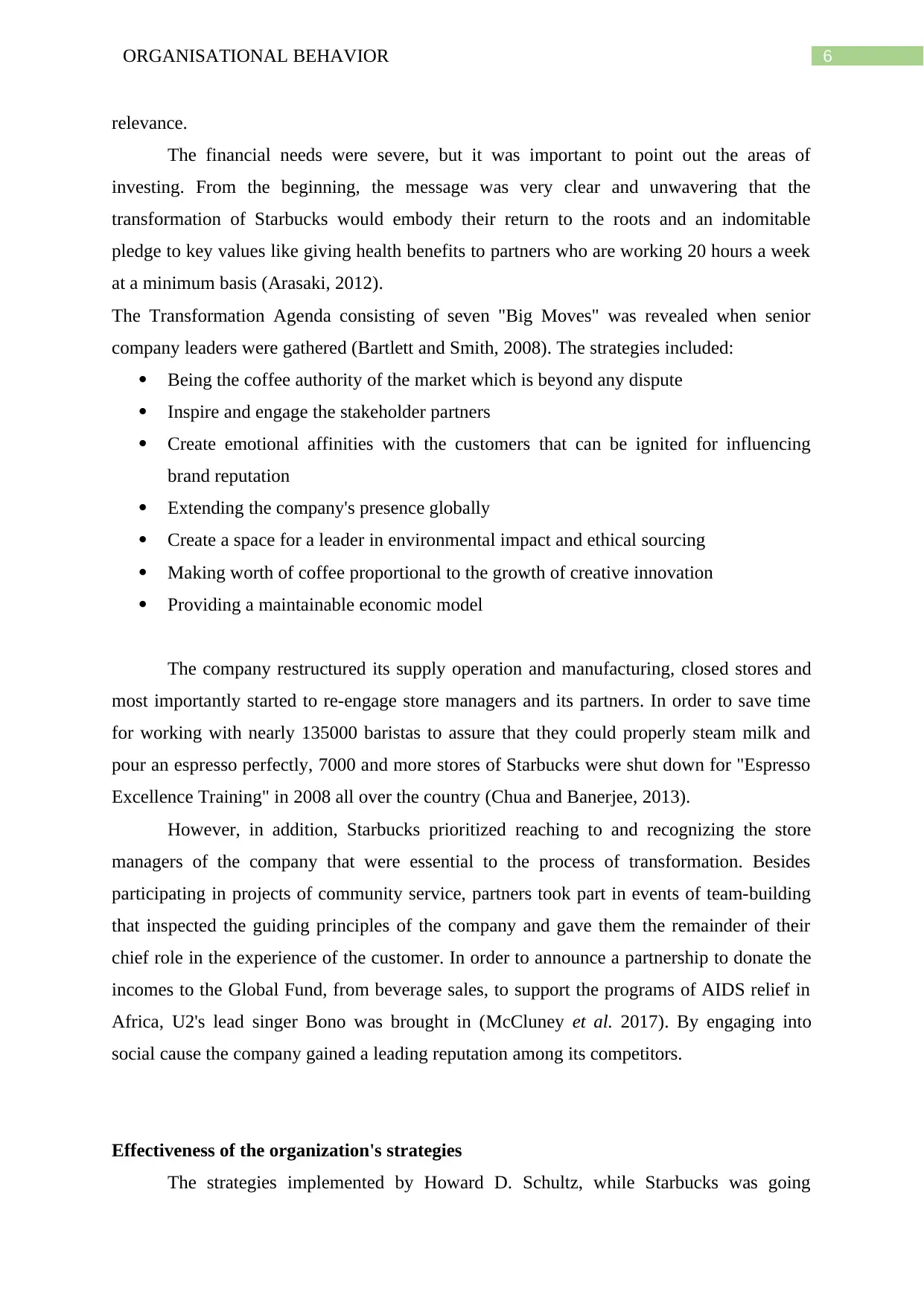
6ORGANISATIONAL BEHAVIOR
relevance.
The financial needs were severe, but it was important to point out the areas of
investing. From the beginning, the message was very clear and unwavering that the
transformation of Starbucks would embody their return to the roots and an indomitable
pledge to key values like giving health benefits to partners who are working 20 hours a week
at a minimum basis (Arasaki, 2012).
The Transformation Agenda consisting of seven "Big Moves" was revealed when senior
company leaders were gathered (Bartlett and Smith, 2008). The strategies included:
Being the coffee authority of the market which is beyond any dispute
Inspire and engage the stakeholder partners
Create emotional affinities with the customers that can be ignited for influencing
brand reputation
Extending the company's presence globally
Create a space for a leader in environmental impact and ethical sourcing
Making worth of coffee proportional to the growth of creative innovation
Providing a maintainable economic model
The company restructured its supply operation and manufacturing, closed stores and
most importantly started to re-engage store managers and its partners. In order to save time
for working with nearly 135000 baristas to assure that they could properly steam milk and
pour an espresso perfectly, 7000 and more stores of Starbucks were shut down for "Espresso
Excellence Training" in 2008 all over the country (Chua and Banerjee, 2013).
However, in addition, Starbucks prioritized reaching to and recognizing the store
managers of the company that were essential to the process of transformation. Besides
participating in projects of community service, partners took part in events of team-building
that inspected the guiding principles of the company and gave them the remainder of their
chief role in the experience of the customer. In order to announce a partnership to donate the
incomes to the Global Fund, from beverage sales, to support the programs of AIDS relief in
Africa, U2's lead singer Bono was brought in (McCluney et al. 2017). By engaging into
social cause the company gained a leading reputation among its competitors.
Effectiveness of the organization's strategies
The strategies implemented by Howard D. Schultz, while Starbucks was going
relevance.
The financial needs were severe, but it was important to point out the areas of
investing. From the beginning, the message was very clear and unwavering that the
transformation of Starbucks would embody their return to the roots and an indomitable
pledge to key values like giving health benefits to partners who are working 20 hours a week
at a minimum basis (Arasaki, 2012).
The Transformation Agenda consisting of seven "Big Moves" was revealed when senior
company leaders were gathered (Bartlett and Smith, 2008). The strategies included:
Being the coffee authority of the market which is beyond any dispute
Inspire and engage the stakeholder partners
Create emotional affinities with the customers that can be ignited for influencing
brand reputation
Extending the company's presence globally
Create a space for a leader in environmental impact and ethical sourcing
Making worth of coffee proportional to the growth of creative innovation
Providing a maintainable economic model
The company restructured its supply operation and manufacturing, closed stores and
most importantly started to re-engage store managers and its partners. In order to save time
for working with nearly 135000 baristas to assure that they could properly steam milk and
pour an espresso perfectly, 7000 and more stores of Starbucks were shut down for "Espresso
Excellence Training" in 2008 all over the country (Chua and Banerjee, 2013).
However, in addition, Starbucks prioritized reaching to and recognizing the store
managers of the company that were essential to the process of transformation. Besides
participating in projects of community service, partners took part in events of team-building
that inspected the guiding principles of the company and gave them the remainder of their
chief role in the experience of the customer. In order to announce a partnership to donate the
incomes to the Global Fund, from beverage sales, to support the programs of AIDS relief in
Africa, U2's lead singer Bono was brought in (McCluney et al. 2017). By engaging into
social cause the company gained a leading reputation among its competitors.
Effectiveness of the organization's strategies
The strategies implemented by Howard D. Schultz, while Starbucks was going
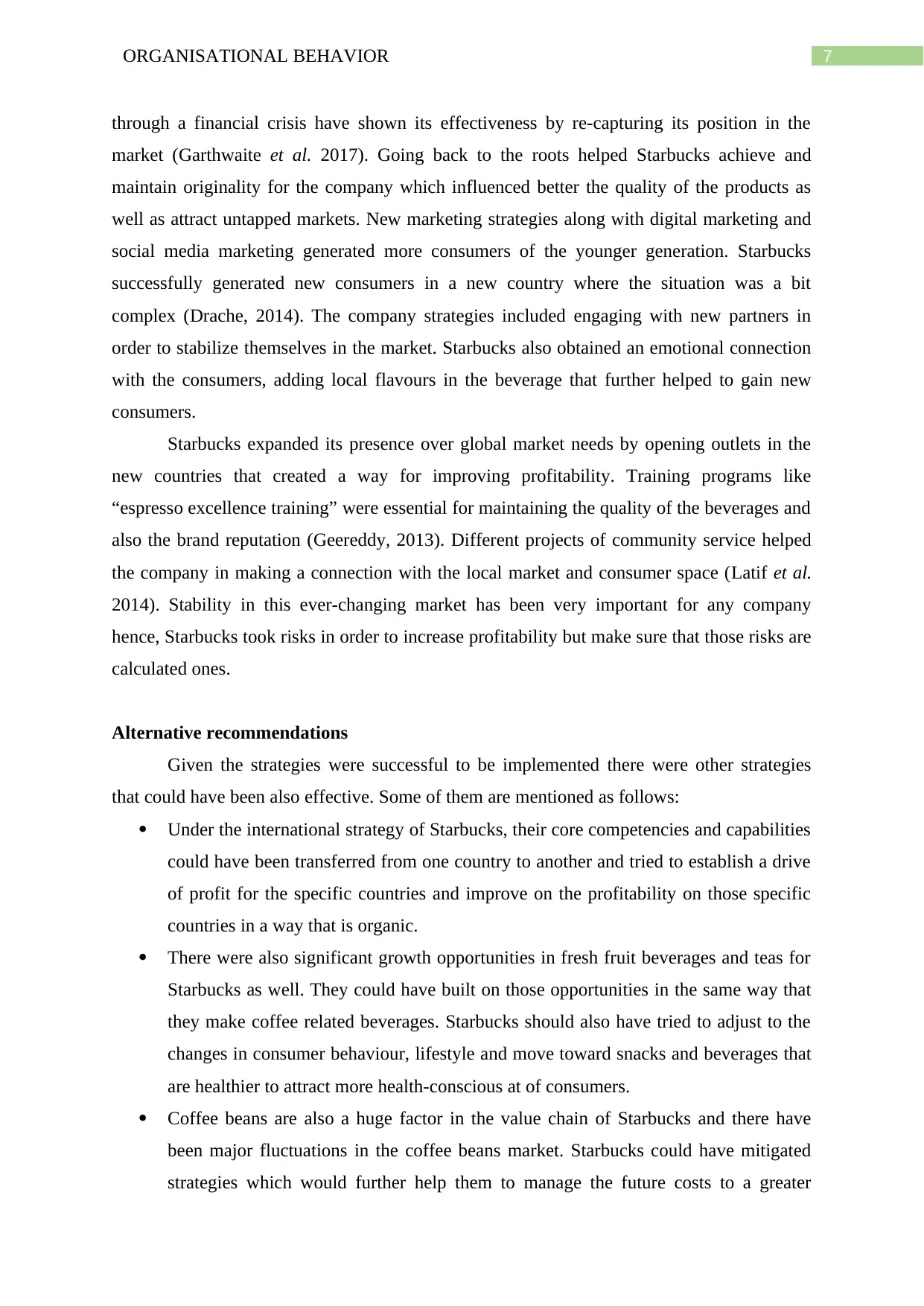
7ORGANISATIONAL BEHAVIOR
through a financial crisis have shown its effectiveness by re-capturing its position in the
market (Garthwaite et al. 2017). Going back to the roots helped Starbucks achieve and
maintain originality for the company which influenced better the quality of the products as
well as attract untapped markets. New marketing strategies along with digital marketing and
social media marketing generated more consumers of the younger generation. Starbucks
successfully generated new consumers in a new country where the situation was a bit
complex (Drache, 2014). The company strategies included engaging with new partners in
order to stabilize themselves in the market. Starbucks also obtained an emotional connection
with the consumers, adding local flavours in the beverage that further helped to gain new
consumers.
Starbucks expanded its presence over global market needs by opening outlets in the
new countries that created a way for improving profitability. Training programs like
“espresso excellence training” were essential for maintaining the quality of the beverages and
also the brand reputation (Geereddy, 2013). Different projects of community service helped
the company in making a connection with the local market and consumer space (Latif et al.
2014). Stability in this ever-changing market has been very important for any company
hence, Starbucks took risks in order to increase profitability but make sure that those risks are
calculated ones.
Alternative recommendations
Given the strategies were successful to be implemented there were other strategies
that could have been also effective. Some of them are mentioned as follows:
Under the international strategy of Starbucks, their core competencies and capabilities
could have been transferred from one country to another and tried to establish a drive
of profit for the specific countries and improve on the profitability on those specific
countries in a way that is organic.
There were also significant growth opportunities in fresh fruit beverages and teas for
Starbucks as well. They could have built on those opportunities in the same way that
they make coffee related beverages. Starbucks should also have tried to adjust to the
changes in consumer behaviour, lifestyle and move toward snacks and beverages that
are healthier to attract more health-conscious at of consumers.
Coffee beans are also a huge factor in the value chain of Starbucks and there have
been major fluctuations in the coffee beans market. Starbucks could have mitigated
strategies which would further help them to manage the future costs to a greater
through a financial crisis have shown its effectiveness by re-capturing its position in the
market (Garthwaite et al. 2017). Going back to the roots helped Starbucks achieve and
maintain originality for the company which influenced better the quality of the products as
well as attract untapped markets. New marketing strategies along with digital marketing and
social media marketing generated more consumers of the younger generation. Starbucks
successfully generated new consumers in a new country where the situation was a bit
complex (Drache, 2014). The company strategies included engaging with new partners in
order to stabilize themselves in the market. Starbucks also obtained an emotional connection
with the consumers, adding local flavours in the beverage that further helped to gain new
consumers.
Starbucks expanded its presence over global market needs by opening outlets in the
new countries that created a way for improving profitability. Training programs like
“espresso excellence training” were essential for maintaining the quality of the beverages and
also the brand reputation (Geereddy, 2013). Different projects of community service helped
the company in making a connection with the local market and consumer space (Latif et al.
2014). Stability in this ever-changing market has been very important for any company
hence, Starbucks took risks in order to increase profitability but make sure that those risks are
calculated ones.
Alternative recommendations
Given the strategies were successful to be implemented there were other strategies
that could have been also effective. Some of them are mentioned as follows:
Under the international strategy of Starbucks, their core competencies and capabilities
could have been transferred from one country to another and tried to establish a drive
of profit for the specific countries and improve on the profitability on those specific
countries in a way that is organic.
There were also significant growth opportunities in fresh fruit beverages and teas for
Starbucks as well. They could have built on those opportunities in the same way that
they make coffee related beverages. Starbucks should also have tried to adjust to the
changes in consumer behaviour, lifestyle and move toward snacks and beverages that
are healthier to attract more health-conscious at of consumers.
Coffee beans are also a huge factor in the value chain of Starbucks and there have
been major fluctuations in the coffee beans market. Starbucks could have mitigated
strategies which would further help them to manage the future costs to a greater
Paraphrase This Document
Need a fresh take? Get an instant paraphrase of this document with our AI Paraphraser
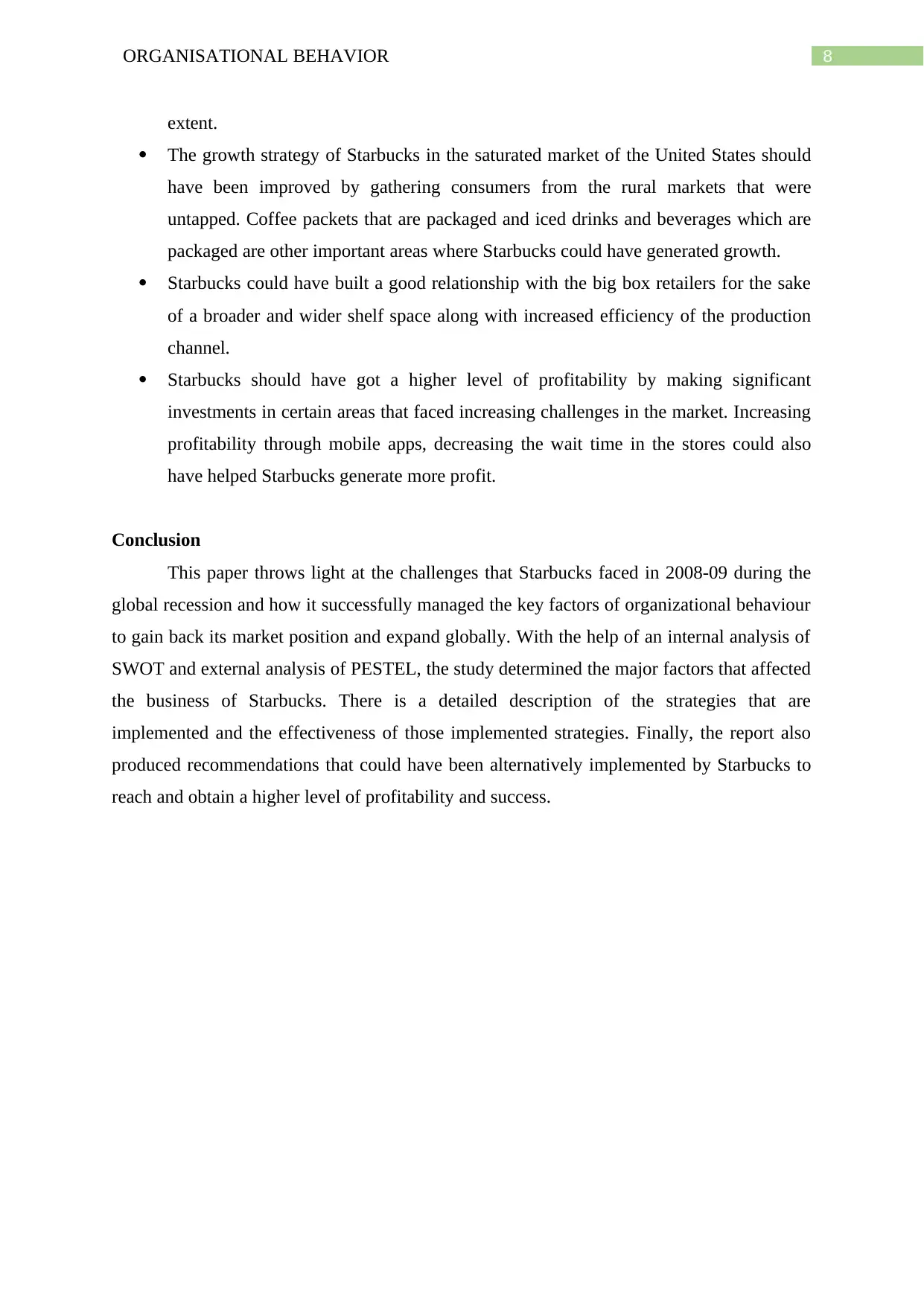
8ORGANISATIONAL BEHAVIOR
extent.
The growth strategy of Starbucks in the saturated market of the United States should
have been improved by gathering consumers from the rural markets that were
untapped. Coffee packets that are packaged and iced drinks and beverages which are
packaged are other important areas where Starbucks could have generated growth.
Starbucks could have built a good relationship with the big box retailers for the sake
of a broader and wider shelf space along with increased efficiency of the production
channel.
Starbucks should have got a higher level of profitability by making significant
investments in certain areas that faced increasing challenges in the market. Increasing
profitability through mobile apps, decreasing the wait time in the stores could also
have helped Starbucks generate more profit.
Conclusion
This paper throws light at the challenges that Starbucks faced in 2008-09 during the
global recession and how it successfully managed the key factors of organizational behaviour
to gain back its market position and expand globally. With the help of an internal analysis of
SWOT and external analysis of PESTEL, the study determined the major factors that affected
the business of Starbucks. There is a detailed description of the strategies that are
implemented and the effectiveness of those implemented strategies. Finally, the report also
produced recommendations that could have been alternatively implemented by Starbucks to
reach and obtain a higher level of profitability and success.
extent.
The growth strategy of Starbucks in the saturated market of the United States should
have been improved by gathering consumers from the rural markets that were
untapped. Coffee packets that are packaged and iced drinks and beverages which are
packaged are other important areas where Starbucks could have generated growth.
Starbucks could have built a good relationship with the big box retailers for the sake
of a broader and wider shelf space along with increased efficiency of the production
channel.
Starbucks should have got a higher level of profitability by making significant
investments in certain areas that faced increasing challenges in the market. Increasing
profitability through mobile apps, decreasing the wait time in the stores could also
have helped Starbucks generate more profit.
Conclusion
This paper throws light at the challenges that Starbucks faced in 2008-09 during the
global recession and how it successfully managed the key factors of organizational behaviour
to gain back its market position and expand globally. With the help of an internal analysis of
SWOT and external analysis of PESTEL, the study determined the major factors that affected
the business of Starbucks. There is a detailed description of the strategies that are
implemented and the effectiveness of those implemented strategies. Finally, the report also
produced recommendations that could have been alternatively implemented by Starbucks to
reach and obtain a higher level of profitability and success.
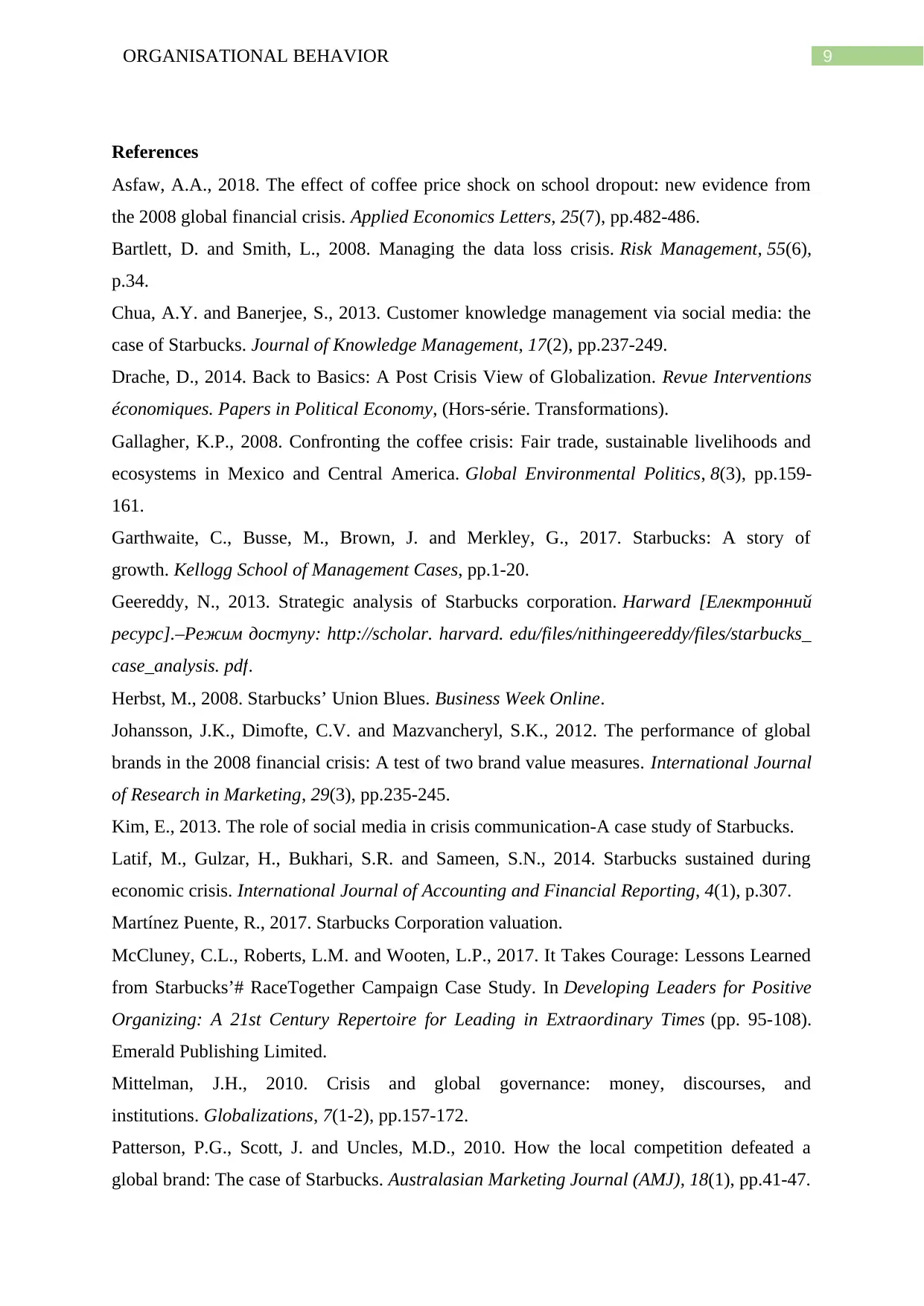
9ORGANISATIONAL BEHAVIOR
References
Asfaw, A.A., 2018. The effect of coffee price shock on school dropout: new evidence from
the 2008 global financial crisis. Applied Economics Letters, 25(7), pp.482-486.
Bartlett, D. and Smith, L., 2008. Managing the data loss crisis. Risk Management, 55(6),
p.34.
Chua, A.Y. and Banerjee, S., 2013. Customer knowledge management via social media: the
case of Starbucks. Journal of Knowledge Management, 17(2), pp.237-249.
Drache, D., 2014. Back to Basics: A Post Crisis View of Globalization. Revue Interventions
économiques. Papers in Political Economy, (Hors-série. Transformations).
Gallagher, K.P., 2008. Confronting the coffee crisis: Fair trade, sustainable livelihoods and
ecosystems in Mexico and Central America. Global Environmental Politics, 8(3), pp.159-
161.
Garthwaite, C., Busse, M., Brown, J. and Merkley, G., 2017. Starbucks: A story of
growth. Kellogg School of Management Cases, pp.1-20.
Geereddy, N., 2013. Strategic analysis of Starbucks corporation. Harward [Електронний
ресурс].–Режим доступу: http://scholar. harvard. edu/files/nithingeereddy/files/starbucks_
case_analysis. pdf.
Herbst, M., 2008. Starbucks’ Union Blues. Business Week Online.
Johansson, J.K., Dimofte, C.V. and Mazvancheryl, S.K., 2012. The performance of global
brands in the 2008 financial crisis: A test of two brand value measures. International Journal
of Research in Marketing, 29(3), pp.235-245.
Kim, E., 2013. The role of social media in crisis communication-A case study of Starbucks.
Latif, M., Gulzar, H., Bukhari, S.R. and Sameen, S.N., 2014. Starbucks sustained during
economic crisis. International Journal of Accounting and Financial Reporting, 4(1), p.307.
Martínez Puente, R., 2017. Starbucks Corporation valuation.
McCluney, C.L., Roberts, L.M. and Wooten, L.P., 2017. It Takes Courage: Lessons Learned
from Starbucks’# RaceTogether Campaign Case Study. In Developing Leaders for Positive
Organizing: A 21st Century Repertoire for Leading in Extraordinary Times (pp. 95-108).
Emerald Publishing Limited.
Mittelman, J.H., 2010. Crisis and global governance: money, discourses, and
institutions. Globalizations, 7(1-2), pp.157-172.
Patterson, P.G., Scott, J. and Uncles, M.D., 2010. How the local competition defeated a
global brand: The case of Starbucks. Australasian Marketing Journal (AMJ), 18(1), pp.41-47.
References
Asfaw, A.A., 2018. The effect of coffee price shock on school dropout: new evidence from
the 2008 global financial crisis. Applied Economics Letters, 25(7), pp.482-486.
Bartlett, D. and Smith, L., 2008. Managing the data loss crisis. Risk Management, 55(6),
p.34.
Chua, A.Y. and Banerjee, S., 2013. Customer knowledge management via social media: the
case of Starbucks. Journal of Knowledge Management, 17(2), pp.237-249.
Drache, D., 2014. Back to Basics: A Post Crisis View of Globalization. Revue Interventions
économiques. Papers in Political Economy, (Hors-série. Transformations).
Gallagher, K.P., 2008. Confronting the coffee crisis: Fair trade, sustainable livelihoods and
ecosystems in Mexico and Central America. Global Environmental Politics, 8(3), pp.159-
161.
Garthwaite, C., Busse, M., Brown, J. and Merkley, G., 2017. Starbucks: A story of
growth. Kellogg School of Management Cases, pp.1-20.
Geereddy, N., 2013. Strategic analysis of Starbucks corporation. Harward [Електронний
ресурс].–Режим доступу: http://scholar. harvard. edu/files/nithingeereddy/files/starbucks_
case_analysis. pdf.
Herbst, M., 2008. Starbucks’ Union Blues. Business Week Online.
Johansson, J.K., Dimofte, C.V. and Mazvancheryl, S.K., 2012. The performance of global
brands in the 2008 financial crisis: A test of two brand value measures. International Journal
of Research in Marketing, 29(3), pp.235-245.
Kim, E., 2013. The role of social media in crisis communication-A case study of Starbucks.
Latif, M., Gulzar, H., Bukhari, S.R. and Sameen, S.N., 2014. Starbucks sustained during
economic crisis. International Journal of Accounting and Financial Reporting, 4(1), p.307.
Martínez Puente, R., 2017. Starbucks Corporation valuation.
McCluney, C.L., Roberts, L.M. and Wooten, L.P., 2017. It Takes Courage: Lessons Learned
from Starbucks’# RaceTogether Campaign Case Study. In Developing Leaders for Positive
Organizing: A 21st Century Repertoire for Leading in Extraordinary Times (pp. 95-108).
Emerald Publishing Limited.
Mittelman, J.H., 2010. Crisis and global governance: money, discourses, and
institutions. Globalizations, 7(1-2), pp.157-172.
Patterson, P.G., Scott, J. and Uncles, M.D., 2010. How the local competition defeated a
global brand: The case of Starbucks. Australasian Marketing Journal (AMJ), 18(1), pp.41-47.
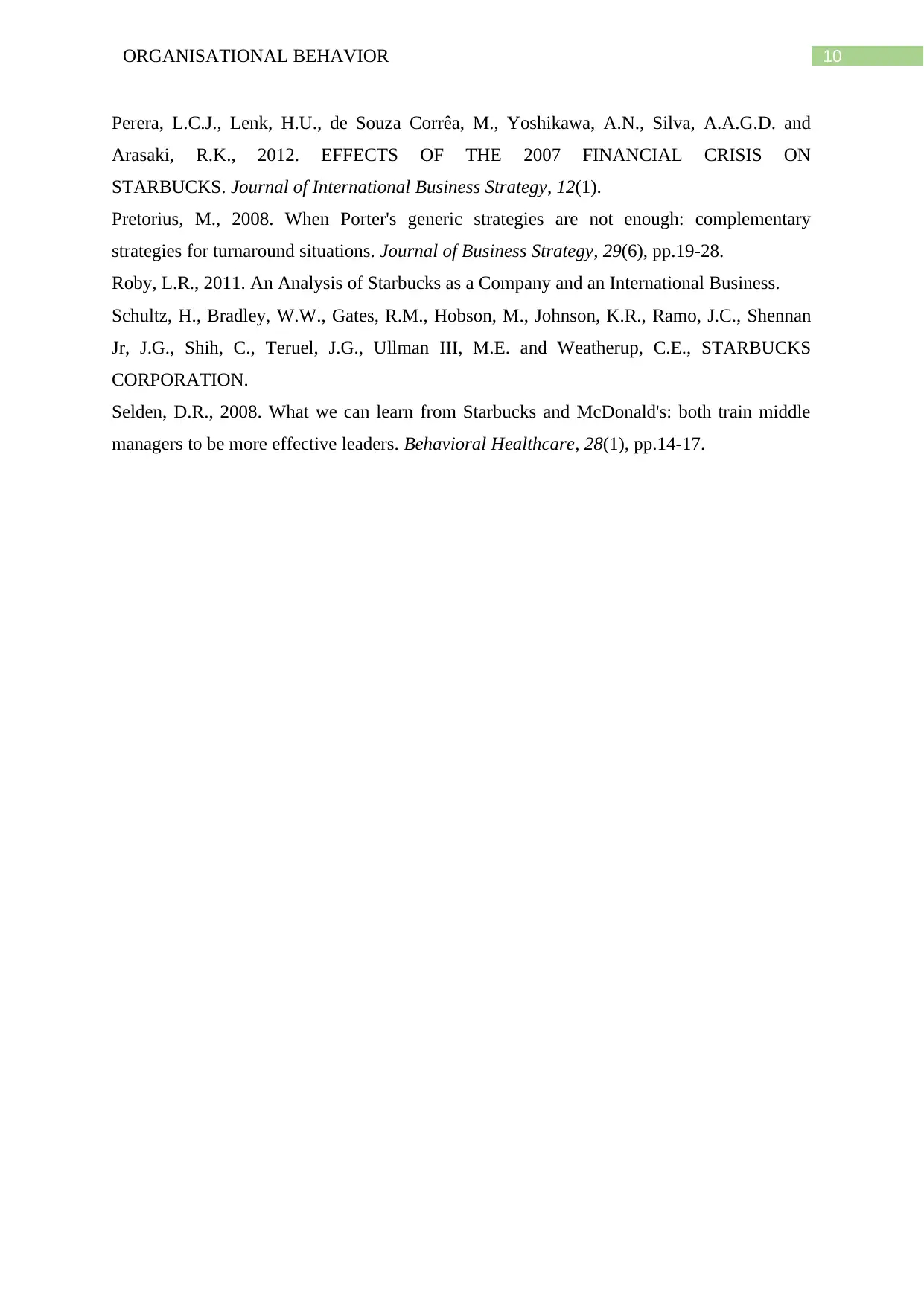
10ORGANISATIONAL BEHAVIOR
Perera, L.C.J., Lenk, H.U., de Souza Corrêa, M., Yoshikawa, A.N., Silva, A.A.G.D. and
Arasaki, R.K., 2012. EFFECTS OF THE 2007 FINANCIAL CRISIS ON
STARBUCKS. Journal of International Business Strategy, 12(1).
Pretorius, M., 2008. When Porter's generic strategies are not enough: complementary
strategies for turnaround situations. Journal of Business Strategy, 29(6), pp.19-28.
Roby, L.R., 2011. An Analysis of Starbucks as a Company and an International Business.
Schultz, H., Bradley, W.W., Gates, R.M., Hobson, M., Johnson, K.R., Ramo, J.C., Shennan
Jr, J.G., Shih, C., Teruel, J.G., Ullman III, M.E. and Weatherup, C.E., STARBUCKS
CORPORATION.
Selden, D.R., 2008. What we can learn from Starbucks and McDonald's: both train middle
managers to be more effective leaders. Behavioral Healthcare, 28(1), pp.14-17.
Perera, L.C.J., Lenk, H.U., de Souza Corrêa, M., Yoshikawa, A.N., Silva, A.A.G.D. and
Arasaki, R.K., 2012. EFFECTS OF THE 2007 FINANCIAL CRISIS ON
STARBUCKS. Journal of International Business Strategy, 12(1).
Pretorius, M., 2008. When Porter's generic strategies are not enough: complementary
strategies for turnaround situations. Journal of Business Strategy, 29(6), pp.19-28.
Roby, L.R., 2011. An Analysis of Starbucks as a Company and an International Business.
Schultz, H., Bradley, W.W., Gates, R.M., Hobson, M., Johnson, K.R., Ramo, J.C., Shennan
Jr, J.G., Shih, C., Teruel, J.G., Ullman III, M.E. and Weatherup, C.E., STARBUCKS
CORPORATION.
Selden, D.R., 2008. What we can learn from Starbucks and McDonald's: both train middle
managers to be more effective leaders. Behavioral Healthcare, 28(1), pp.14-17.
1 out of 10
Your All-in-One AI-Powered Toolkit for Academic Success.
+13062052269
info@desklib.com
Available 24*7 on WhatsApp / Email
![[object Object]](/_next/static/media/star-bottom.7253800d.svg)
Unlock your academic potential
© 2024 | Zucol Services PVT LTD | All rights reserved.


